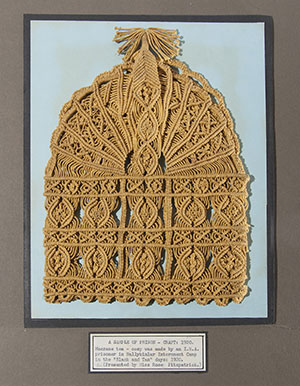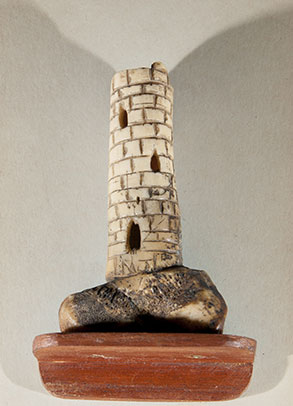Internment during the War of Independence
Published in Artefacts, Issue 4 (July/August 2019), Volume 27By Lar Joye

Above: A macramé tea cosy made by an IRA prisoner in Ballykinlar internment camp, 1920.
The British government trained many of their opponents without realising it. After the 1916 Rising, it conveniently imprisoned many of the rebels together at Frongoch camp in Wales, where they exchanged ideas and planned strategy for the struggle to come. After the Rising, many leaders found themselves in jail again under the Defence of the Realm Act in 1917 and after the conscription crisis in April 1918, when 80 prominent leaders were imprisoned. Irish prisons filled once more during the War of Independence; there were 1,343 political prisoners in Ireland by the start of 1921.
After Bloody Sunday on 21 November 1920 there were widespread arrests of suspected IRA members, and camps were opened in Ballykinlar, Co. Down, and Bere Island, Co. Cork. By April 1921 more than 3,300 suspected IRA members were interned, with new camps on Spike Island and two camps in the Curragh, Co. Kildare. By the time of the Truce the IRA was short of weapons and, more importantly, volunteers; those imprisoned now numbered 4,000.

Above: A round tower carved out of a meat bone by Patrick Coughlan from Liverpool, an IRA prisoner in Mountjoy Jail.
To pass the time, prisoners attended lectures, established camp orchestras and trained. In response to their jailing there were escapes, such as Éamon de Valera’s from Lincoln Jail in February 1919, and a campaign of hunger strikes, most famously by Terence MacSwiney, who died after 74 days without food. As can be seen here, with such large numbers in prison an important collection of material culture has survived, with autograph books and prison art from animal bone and textiles documenting the prisoners’ experiences. The British government always lacked good intelligence on the IRA during the war and the bugging of internees in the Curragh Camp was a novel way of obtaining information.
The objects here are from the Brother Allen Collection, which is now displayed and stored at the new Military Archives building in Cathal Brugha Barracks. As a teacher in O’Connell Schools in North Richmond Street, Brother William Palladius Allen (1892–1984) collected a nationally significant archive and museum collection relating to the 1916 Rising.
Lar Joye is Heritage Officer, Dublin Port.
















